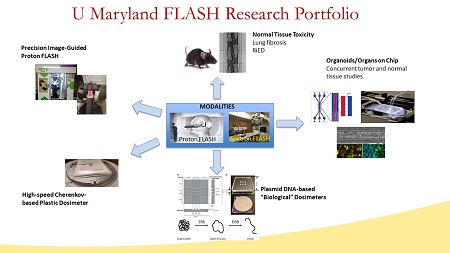Research in FLASH
FLASH Radiotherapy at the University of Maryland
FLASH radiation therapy (RT) is a treatment technique which administers an ultra-high dose of radiation therapy in less time and spares surrounding healthy tissue, without compromising tumor control.
At the University of Maryland, we offer a robust portfolio of ongoing FLASH research. Our unique center houses electron FLASH, proton FLASH, and precision small animal image-guidance platforms in our proton FLASH facility,  the Maryland Proton Treatment Center (MPTC). We also offer FLASH irradiation, a spatially-localized radioprotector which increases the therapeutic index. These modalities allow us to explore the widest possible variety of research topics. While some of these projects are more physics-based (for example, the development of Cherenkov high-speed dosimeters), FLASH research fosters collaborative work between our department’s physicists, clinicians, and biologists in the Division of Translational Radiation Sciences (DTRS). Current projects that our department faculty are actively working on include:
the Maryland Proton Treatment Center (MPTC). We also offer FLASH irradiation, a spatially-localized radioprotector which increases the therapeutic index. These modalities allow us to explore the widest possible variety of research topics. While some of these projects are more physics-based (for example, the development of Cherenkov high-speed dosimeters), FLASH research fosters collaborative work between our department’s physicists, clinicians, and biologists in the Division of Translational Radiation Sciences (DTRS). Current projects that our department faculty are actively working on include:
- Preclinical models of normal tissue response to FLASH
- Image-guided studies using orthotopic mouse models to characterize tumor control and normal tissue sparing in the same animal
- Biological dosimeters based on plasmid DNA chips
- 3D organoids and organs on chips, which can be used to explore the large parameter space in FLASH RT and determine optimal doses, dose rates, oxygenation, etc.
FLASH Basics

- Consensus Definition: Radiation dose rates >40 Gy/s
- ~2 orders of magnitude > conventional irradiation
- “FLASH effect” spares normal tissue without compromising tumor control
- In essence, FLASH irradiation is a spatially-localized radioprotector that increases the therapeutic index
Department Investments in FLASH

In 2020, the department made a $1.8 million commitment across all three of our divisions to elucidate the basic science of high-dose-rate FLASH radiotherapy techniques, conduct and report on translational studies, and implement the knowledge gained in clinical applications. This unusual self-investment effort positions the department at the forefront of a technique with the potential to revolutionize radiation treatment and expand understanding of related basic radiation biology. Under the direction of vice chair for medical physics Amit Sawant, PhD, we have completed major technology realignment and launched a range of associated basic and translational activities:
Precision Image-Guided Proton FLASH
- Decommissioning and converting a LINAC machine to an electron FLASH delivery system at the University of Maryland Medical Center (UMMC) and enabling FLASH beam technology at the Maryland Proton Treatment Center (MPTC);
- Installing a small-animal radiation research platform at MPTC for more complex studies that more closely mirror clinical applications and enable documentation of basic technical parameters for future clinical regimens;
- Participating at the national level in FLASH consortia, professional meeting presentations, and related work groups;
- Conducting a program in preclinical FLASH research under DTRS director France Carrier, PhD, to evaluate mechanisms underlying ultra-high-dose-rate effects on normal and tumor tissues.
To learn more about FLASH RT, please contact Amit Sawant, PhD at asawant@som.umaryland.edu or France Carrier, PhD at fcarrier@som.umaryland.edu.
